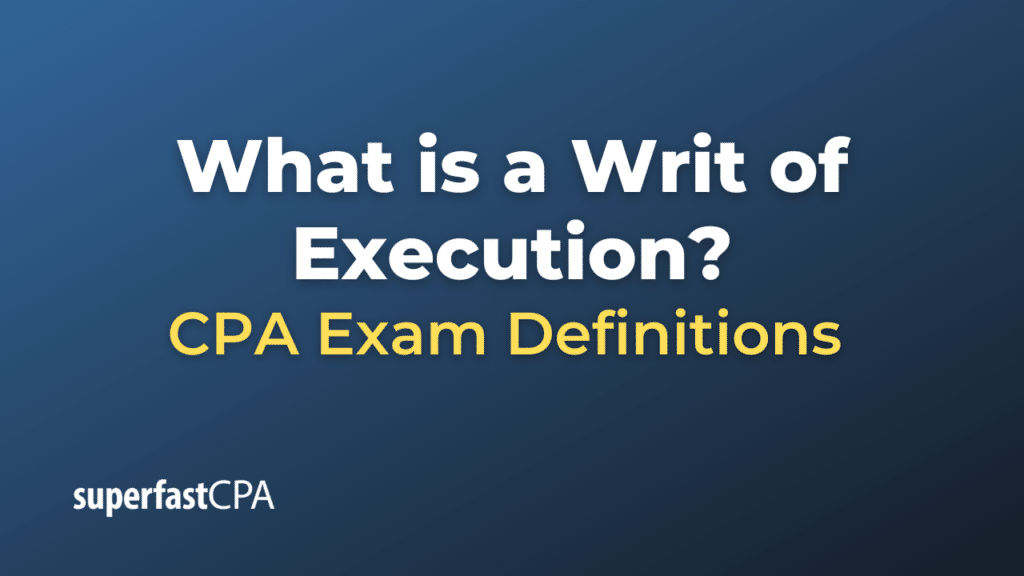Writ of Execution
A “Writ of Execution” is a court order that authorizes the seizure of assets belonging to a judgment debtor to satisfy a monetary judgment awarded to a creditor or plaintiff. This writ is typically the final step in a civil lawsuit process aimed at recovering a debt or obtaining payment. Once a court issues a judgment in favor of the plaintiff or creditor, if the defendant or debtor does not voluntarily comply with the judgment, a writ of execution can be issued.
The writ grants law enforcement agencies, such as sheriffs or marshals, the authority to seize the debtor’s property, sell it, and then use the proceeds to pay the creditor. The types of property that can be seized and the procedures for doing so will vary depending on the jurisdiction and the nature of the debt. This may include real property, personal property, or even bank accounts.
General Steps for Writ of Execution:
- Judgment Issued: The court issues a judgment in favor of the creditor.
- Writ of Execution Request: If the debtor does not comply, the creditor may request the court to issue a writ of execution.
- Court Approval: The court reviews the request and, if applicable, issues the writ.
- Service and Enforcement: Law enforcement officials serve the writ to the debtor and may also seize assets as authorized by the writ.
- Sale of Assets: Typically, seized assets are auctioned off, and the proceeds are used to pay the creditor. Any leftover funds are returned to the debtor.
- Settlement and Closing: Once the debt is settled through the sale of assets, the case is usually closed, although some additional steps may be needed to finalize the process, such as filing reports with the court.
Note:
The use of a writ of execution is often the last resort and typically follows specific procedures and legal requirements, such as providing notices to the debtor, allowing opportunities to repay, and adhering to exemptions and limitations set by law. Failure to follow these can lead to legal consequences. Therefore, both creditors and debtors should consult legal advice when dealing with writs of execution.
Example of a Writ of Execution
Let’s consider a hypothetical example to illustrate how a Writ of Execution works.
Example Scenario:
Participants:
- Creditor: Sarah, a freelance graphic designer
- Debtor: Mike, owner of a small marketing firm
- Court: Small Claims Court
- Law Enforcement: Local Sheriff’s Office
Situation:
Sarah completed a project for Mike’s marketing firm but has not been paid the agreed-upon fee of $5,000 despite multiple invoices and reminders. Sarah decides to take legal action and files a lawsuit in small claims court. After hearing both sides, the court issues a judgment in favor of Sarah, ordering Mike to pay the $5,000 owed.
Steps Following the Judgment:
- Non-compliance by Debtor: Despite the court order, Mike still fails to pay Sarah the amount owed.
- Request for Writ of Execution: Sarah goes back to the court and applies for a Writ of Execution, submitting the required documents and fees.
- Issuance of Writ: The court reviews the application and issues a Writ of Execution, authorizing the seizure and sale of Mike’s assets to satisfy the debt.
- Notification and Execution: The Writ of Execution is delivered to the local Sheriff’s Office, who then serves it to Mike. Mike is given a brief period (as stipulated by jurisdiction) to comply voluntarily or face asset seizure.
- Seizure of Assets: Mike still doesn’t pay, and the Sheriff seizes one of Mike’s company vehicles, which is worth approximately $7,000.
- Auction: The seized vehicle is auctioned off, and it fetches $6,000.
- Debt Settlement: Out of the $6,000 received from the auction, the sheriff deducts applicable fees and gives the remaining amount to Sarah. Since the amount is more than enough to cover the debt of $5,000, Sarah is paid in full, and the excess money is returned to Mike.
- Case Closed: Once the debt is paid, the case is closed. Sarah may need to file paperwork to inform the court that the judgment has been satisfied.
Additional Notes:
- Mike could have avoided asset seizure at several points by settling the debt as soon as he was aware of the legal actions against him.
- The example demonstrates that non-compliance with a court judgment could lead to significant consequences, such as asset seizure and sale.
- The exact laws and regulations concerning Writs of Execution can differ significantly by jurisdiction, and it is crucial for both creditors and debtors to understand their legal rights and responsibilities in these situations.
This example highlights the process and implications of a Writ of Execution and serves as a cautionary tale for both creditors and debtors.













